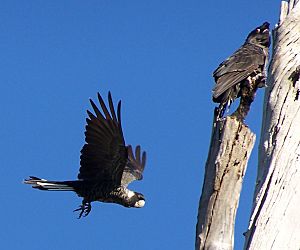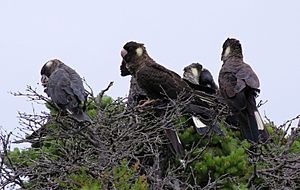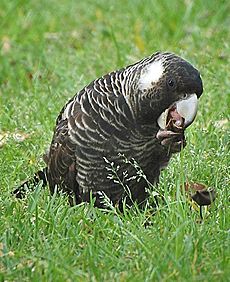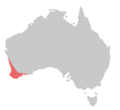Carnaby's black cockatoo facts for kids
Quick facts for kids Carnaby's black cockatoo |
|
|---|---|
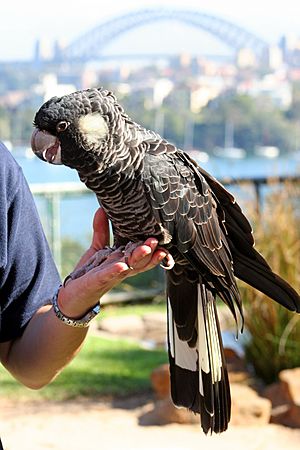 |
|
| Female, Taronga Zoo | |
| Conservation status | |
| Scientific classification | |
| Genus: |
Zanda
|
| Species: |
latirostris
|
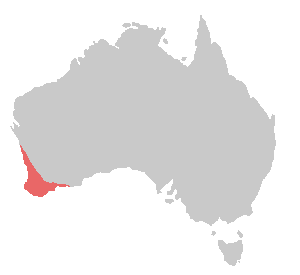 |
|
| Range in red | |
| Synonyms | |
|
|
The Carnaby's black cockatoo (Zanda latirostris), also known as the short-billed black cockatoo, is a large black cockatoo. It lives only in southwest Australia. A naturalist named Ivan Carnaby first described it in 1948.
This cockatoo is about 53 to 58 centimeters (21 to 23 inches) long. It has a short crest on its head. Its feathers are mostly greyish-black. It has clear white patches on its cheeks and a white band on its tail. The edges of its body feathers are white, making them look like scales. Adult males have a dark grey beak and pink rings around their eyes. Adult females have a bone-coloured beak, grey eye-rings, and paler ear patches.
Carnaby's black cockatoo usually lays one or two eggs. The female sits on the eggs for 28 to 29 days. The young birds leave the nest about ten to eleven weeks after hatching. They stay with their family until the next breeding season, or sometimes even longer. When not breeding, these cockatoos form large groups. Birds in drier areas tend to migrate more than those in wetter places. They fly with deep, slow wingbeats, usually high above the trees. They mostly eat seeds from plants like Proteaceae and Myrtaceae.
This cockatoo builds its nests in hollows high up in large Eucalyptus trees. Much of its home has been lost due to land clearing and building. Because of this, the Carnaby's black cockatoo is an endangered species. Both the Federal and Western Australian governments list it as endangered. The International Union for the Conservation of Nature (IUCN) also calls it endangered. Like most parrots, it is protected by CITES. This international agreement makes it illegal to trade, export, or import these wild birds.
Contents
About the Carnaby's Black Cockatoo
How the Carnaby's Cockatoo Got Its Name
The Carnaby's black cockatoo and the Baudin's black cockatoo were once thought to be the same bird. They were called the white-tailed black cockatoo. But scientists later found they were different species. In 1933, a naturalist named Ivan Carnaby studied birds in Lake Grace, Western Australia. He noticed a special group of white-tailed black cockatoos. He called them mallee black cockatoos. These birds lived in mallee areas and sandplains. They used their big beaks to open tough seed pods.
In 1948, Ivan Carnaby officially named it a subspecies. He called it Calyptorhynchus baudinii latirostris. The name latirostris comes from Latin words meaning "wide" and "bill." This shows that its beak is wider than other similar birds. The first official specimen was found in Hopetoun, Western Australia.
The Carnaby's black cockatoo belongs to the genus Zanda. This group also includes the Baudin's black cockatoo and the yellow-tailed black cockatoo. Another group of black cockatoos, like the red-tailed black cockatoo and glossy black cockatoos, are in the genus Calyptorhynchus. These two groups are different in how their young birds beg for food. Also, the males and females look very different in the Calyptorhynchus group, but similar in the Zanda group.
For many years, scientists debated if the three Zanda species were one or two species. In the 1970s, an Australian bird expert, Denis Saunders, studied the two white-tailed species. He found that Baudin's black cockatoo had longer wings and a bigger skull than Carnaby's. Their bill lengths also did not overlap. Later studies in 1984 showed that the two Western Australian forms were more closely related to each other. So, now they are treated as three separate species.
Even though scientists used names like "short-billed" and "long-billed," people in Western Australia called them Carnaby's and Baudin's. So, bird experts decided to use these common names. The International Ornithologists' Union now uses these names officially. The local Noongar people did not have different names for Carnaby's and Baudin's black cockatoos. Some Nyungar names for them include ngolyenok, ngoolyoo, and G'noo-le-a.
What Carnaby's Cockatoos Look Like
A Carnaby's black cockatoo is about 53 to 58 centimeters (21 to 23 inches) long. Its wingspan is about 110 centimeters (43 inches). It weighs between 520 and 790 grams (1.1 to 1.7 pounds). Most of its body is greyish-black. Its feathers have narrow light grey edges, which makes them look like scales. This pattern is clearer on its neck.
It has a crest of feathers on its head that is about 2.5 to 3 centimeters (1 to 1.2 inches) long. This crest can be raised or lowered. It also has a clear off-white patch of feathers on its cheek. The outer feathers of its tail are white with black tips, while the middle tail feathers are all black. Its eyes are dark brown, and its legs are brown-grey. Its beak is shorter and wider than the similar Baudin's black cockatoo. It can be hard to tell the two species apart in the wild.
Adult males have a dark grey beak and pink rings around their eyes. Adult females have a bone-coloured beak and grey eye-rings. Their ear patches are whiter and stand out more than the males'. The feathers on their belly and under their wings have larger white edges. This gives them a more striped or scaled look. Their legs and feet are a bit lighter than the males'. These birds shed their feathers (called moulting) in stages from late summer to late spring.
Young cockatoos have a bone-coloured beak and grey eye-rings. They also have less white in their tail feathers. You can tell them apart by their constant begging calls. It's hard to tell if a young bird is male or female until the male's beak starts to get darker. This happens when the male is about one year old and finishes after two years.
Where Carnaby's Cockatoos Live
Carnaby's black cockatoo lives in a large area of southwest Australia. This is mostly in the Wheatbelt region, where it rains more than 300 millimeters (12 inches) each year. Its range stretches from Cape Arid in the east to Kalbarri in the north. It also lives inland around Lake Cronin and Lake Moore.
They breed in areas that get 350 to 700 millimeters (14 to 28 inches) of rain each year. These areas are from the Stirling Range to Three Springs and near Bunbury. Outside the breeding season, pairs of cockatoos form flocks and move away from their nesting spots. Carnaby's black cockatoos stay in one place in wetter areas. But in drier areas, they migrate south and west towards the coast in summer.
You can find Carnaby's black cockatoos in Eucalyptus woodlands. They especially like wandoo (Eucalyptus wandoo) or salmon gum (E. salmonophloia) trees. They also live near pine plantations and sandy plains or kwongan heath. These areas have many Hakea, Banksia, and Grevillea shrubs.
How Carnaby's Cockatoos Behave
Carnaby's black cockatoos use sounds and movements to talk to each other. They are usually noisy. Their loudest and most common call is a wailing wy-lah. Both males and females make this sound. You can often hear it before you see the birds. They make this call when flying, before taking off, and when returning to the nest. Other cockatoos might answer with the same call. The call changes a bit between individual birds. Older chicks can even tell their parents' calls apart.
Birds often make a soft chuck sound when they are alone. Females make a two-note whistling call when perched or about to fly. They also make a long, single-note whistle when alone. Males make a soft, short wy-lah call in similar situations. If they notice something is wrong, they might make a harsh screeching alarm call. They squawk loudly when fighting with other cockatoos, when other animals enter their breeding area, or when people handle them. Males can make a harsh chattering squeak when arguing with other males.
Males make two types of calls to females, sometimes before mating. One is a series of short squeaks. The other is made of many ah notes. These calls can be short or last for several minutes. Young birds make a noisy, grating begging call when they want food. An adult female might also make this call while sitting on her eggs.
Carnaby's black cockatoo flies with deep, slow wingbeats. This makes it look like it's moving in waves. It can also glide for a long time with its wings held down. Flocks usually fly high up. They come down to the tops of trees to eat or rest. These birds can move quickly if they are scared. But on the ground, they walk awkwardly.
The oldest Carnaby's black cockatoo found through banding lived for 25 years and 10 months. This bird was banded in 1988 and found again in 2014.
How Carnaby's Cockatoos Breed
Carnaby's black cockatoos start breeding when they are about four years old. They stay with the same mate for their whole lives. Old wandoo and salmon gum woodlands are important for breeding. This is because the cockatoos need large hollows in tall trees for their nests. Nests are usually about 5.7 meters (19 feet) above the ground. They are typically about 174 meters (571 feet) apart from each other.
These cockatoos compete for nest hollows with other birds like western corellas and galahs. They also compete with feral honeybees. Galahs look for hollows all year, but Carnaby's black cockatoos only look before breeding. Mated pairs come back to their breeding area in late winter. The female chooses a good hollow in a tree. She becomes very protective of her territory, chasing away other females. After a bushfire in 2009 destroyed much of their breeding habitat, wildlife officers made artificial nesting hollows. After some trials, the number of young birds surviving in these hollows increased to 75%.
The breeding season is from late winter to summer. The female lays one or two white eggs. If she lays two eggs, the second one comes about eight days after the first. One egg is usually larger in a two-egg clutch. An egg is about 44 to 54 millimeters (1.7 to 2.1 inches) long and 32 to 41 millimeters (1.3 to 1.6 inches) wide. The second egg is usually about 3 millimeters shorter. An egg weighs about 33 grams (1.2 ounces), which is about 5% of the female's weight.
The female sits on the eggs alone for 28 to 29 days. The eggs hatch at different times, with the second chick hatching about eight days after the first. The second chick usually dies within the first two days. Only a few second chicks survive. Newly hatched chicks have pale yellow down and cannot see. They can sit up but cannot do much else. By the third week, their eyes start to open. They look greyish as black feathers begin to grow under their down. By week five, most of the down is gone, and the black feathers and pale cheek patch are clear. Young females have a whiter cheek patch from this age. Both parents usually feed the young birds. The chicks leave the nest about ten to eleven weeks after hatching. They usually stay with their parents until at least the next breeding season, or even longer. The family leaves the nesting area until they return to breed the next year.
What Carnaby's Cockatoos Eat
The Carnaby's black cockatoo is a plant-eater. It mainly eats seeds from proteaceous plants. These include Banksia, Hakea, and Grevillea. It also eats seeds from myrtaceous plants like Eucalyptus and Corymbia. It uses over fifty native plant species for food, eating their seeds or flowers. Some of these include western sheoak (Allocasuarina fraseriana), orange wattle (Acacia saligna), and balga (Xanthorrhoea preissii).
Typically, these cockatoos sit in the tops of trees. They crack open seed pods or cones. First, a bird chews through the stem holding the seed pod. Then, it holds the pod with its foot and tears off pieces to get the seed. Birds might also break stems randomly along branches. Sometimes, they look for fallen seeds and fruit on the ground. This cockatoo also helps control pests. It eats the larvae of insects like wood-boring insects and moths from rare plants.
The Swan Coastal Plain north of Perth has become an important feeding area. Here, cockatoos also find food in the Gnangara pine plantations. They eat the seeds of Monterey pine (Pinus radiata) and maritime pine (Pinus pinaster). Carnaby's black cockatoos have relied on these plantations since the early 1900s. Almost two-thirds of the Carnaby's black cockatoos in the Perth–Peel Coastal Plain rest in the Gnangara-Pinjar pine plantation.
They also eat seeds from other non-native plants. These include Erodium species, doublegee (Emex australis), and the fruit of the umbrella tree (Schefflera actinophylla). They also eat seeds from liquidambar (Liquidambar styraciflua), sunflower (Helianthus annuus), jacaranda (Jacaranda mimosifolia), almond (Prunus amygdalus), onion grass (Romulea rosea), white cedar (Melia azedarach), and hibiscus flowers.
When not breeding, a Carnaby's black cockatoo searches for food over an area of 17 to 276 square kilometers (6.6 to 106.6 square miles) around its resting spots. However, daily movements are usually short. Birds travel about 5.4 kilometers (3.4 miles) from their roost in the morning and 5.5 kilometers (3.4 miles) in the afternoon.
Protecting Carnaby's Black Cockatoo
Threats to the Cockatoo
The Carnaby's black cockatoo is listed as endangered by the Australian government. Western Australia also lists it as "fauna that is rare or is likely to become extinct." The number of Carnaby's cockatoos dropped by more than half in 45 years. About one-third of their traditional breeding grounds in the Wheatbelt have been left empty.
Each year since 2009, there has been a census called the Great Cocky Count. This count tracks the number of Carnaby's and other black cockatoos. In 2016, the count found 10,919 Carnaby's black cockatoos. This showed that the population on the Perth–Peel Coastal Plain had dropped by 50% since 2010. It was falling by about 10% each year. The total number of these birds is thought to be around 40,000.
The biggest dangers to the cockatoo are:
- Loss of habitat: Their feeding and nesting areas are being cleared.
- Destroyed nests: Nesting hollows are being destroyed, for example, when people collect firewood.
- Competition: Other species compete for nest sites.
- Poaching: Illegal hunting or capture of the birds.
Since European settlement, 56% of the cockatoo's habitat has been cleared, mostly for farming. Also, 54% of its habitat on the Swan Coastal Plain, which is important outside the breeding season, has been lost. Much of this area is now part of the Perth city area. Perth's population is expected to grow by 70% by 2050. The Western Australian government has a plan to manage this growth. However, conservation groups worry that the cockatoo could lose even more habitat. The loss of pine plantations north of Perth is a big concern, as these provide food for the birds. In February 2017, WWF-Australia and BirdLife Australia asked the government to stop the removal of pine trees.
BirdLife International has named 13 sites as important for Carnaby's black cockatoo. These are called Important Bird Areas. The Northern Swan Coastal Plain supports between 4,600 and 15,000 birds outside the breeding season. The Stirling Range and 11 other sites support between 20 and 110 breeding pairs.
The species reproduces slowly and takes a long time to grow up. This makes it hard for them to adapt quickly to changes in their environment. Their habit of forming flocks also makes them vulnerable to diseases and bad weather. For example, a disease outbreak likely killed up to 23 breeding female cockatoos in 2009. A hailstorm killed 68 birds near Perth in 2010. And 145 birds died in a heatwave near Hopetoun in 2010 when temperatures reached 48 degrees Celsius (118 degrees Fahrenheit). Extreme weather in southwest Australia is expected to get worse with climate change.
Carnaby's black cockatoos have also been taken to animal hospitals with injuries. Cars are a danger because much of the plants they use are along roads. When the cockatoos fly out of these plants, they often fly over the road into the path of cars.
Like most parrots, Carnaby's black cockatoo is protected by CITES. It is on the Appendix II list of vulnerable species. This means it is illegal to import, export, or trade these wild-caught birds.
Images for kids
-
Female, Taronga Zoo
See also
 In Spanish: Cacatúa fúnebre piquicorta para niños
In Spanish: Cacatúa fúnebre piquicorta para niños



